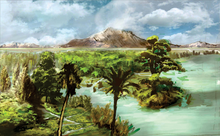Danian
Template:Paleogene The Danian is the oldest age or lowermost stage of the Paleocene epoch or series, the Paleogene period or system and the Cenozoic era or erathem. The beginning of the Danian age (and the end of the preceding Maastrichtian age) is at the Cretaceous–Paleogene extinction event 66 Ma. The age ended 61.6 Ma, being followed by the Selandian age.[1]
Stratigraphic definitions

The Danian was introduced in scientific literature by German-Swiss geologist Pierre Jean Édouard Desor in 1847. It is named after the Latin name for Denmark. The Montian stage from Belgian stratigraphy (named after the city of Mons) is now known to be roughly equivalent to the Upper Danian and is considered a junior synonym and is no longer in use.[2]
The base of the Danian is defined at the iridium anomaly which characterized the Cretaceous–Paleogene boundary (K–T boundary) in stratigraphic sections worldwide. A section in El Kef, Tunisia was appointed as a reference profile (GSSP) for this important boundary.[3] The Danian is the oldest age of the Paleocene, defined at its base by the K-Pg boundary. It is very important because the readily recognized iridium anomaly and primitive Danian planktonic foraminifers define the base of the Danian. Danian foraminiferans repopulated the Paleocene seas after the Cretaceous mass extinction (Olsson et al., 1996). The first replacement foraminiferan of the Paleogene is the Globigerina eugubina, which is used to define the base of the Danian Age (Stainforth et al., 1975). This foraminiferan replaced the Cretaceous genus Globotruncana.
The top of the Danian stage (the base of the Selandian) is close to the boundary between biozones NP4 and NP5 from marine biostratigraphy. It is slightly after the first appearances of many new species of the calcareous nanoplankton genus Fasciculithus (F. ulii, F. billii, F. janii, F. involutus, F. tympaniformis and F. pileatus) and close to the first appearance of calcareous nanoplankton species Neochiastozygus perfectus.
The Danian stage overlaps the Puercan and Torrejonian North American land mammal ages and the Shanghuan and lowest part of the Nongshanian Asian land mammal ages. It includes the oldest Mammal Paleogene zones, all included in the 1 - 5 group.[4]
Palaeontology
Though the non-avian dinosaurs were gone, the mammals, and other land animals remained small, most not even bigger than a sheep; however; a few (like Ankalagon saurognathus) reached the size of a medium-sized bear. Numerous lineages of modern birds also survived, particularly in the area around Australia but also elsewhere, e.g. Scaniornis of the North Sea region. The oceans remained much the same as the Late Cretaceous seas, only that there was less life, few remaining marine reptiles (all of which were turtles and crocodiles), and other lesser known animals.
References
Notes
- ^ Cite error: The named reference
ICS2013was invoked but never defined (see the help page). - ^ De Geyter G.; De Man E.; Herman J.; Jacobs P.; Moorkens T.; Steurbat E.; Vandenberghe N. (2006). "Disused Paleogene regional stages from Belgium: Montian, Heersian, Landenian, Paniselian, Bruxellian, Laekenian, Ledian, Wemmelian and Tongrian". Geologica Belgica. 9 (1–2): 203–213.
- ^ The GSSP for the Danian stage was established by Molina et al. (2006)
- ^ Alroy, John. "Mammal Paleogene zones". Fossilworks: Gateway to the Paleobiology Database. Retrieved 2016-10-13.
Literature
- Desor, P.J.É.; 1847: Sur le terrain Danien, nouvel étage de la craie, Bulletin de la Societé Géologique de France, série 2, 3, p. 179-181, ISSN 0037-9409. Template:Fr icon
- Gradstein, F.M.; Ogg, J.G. & Smith, A.G.; 2004: A Geologic Time Scale 2004, Cambridge University Press.
- Molina, E.; Alegret, L.; Arenillas, I.; Arz, J.A.; Gallala, N.; Hardenbol, J.; Salis, K. von; Steurbaut, E.; Vandenberghe, N. & Zaghbib-Turki, D.; 2006: The Global Boundary Stratotype Section and Point for the base of the Danian Stage (Paleocene, Paleogene, "Tertiary", Cenozoic) at El Kef, Tunisia: original definition and revision, Episodes 29(4), p. 263-273, ISSN 0705-3797.
- Olsson, R.K., Liu, C., and Van Fossen, M.; 1996:The Cretaceous-Tertiary catastrophe event at Millers Ferry, Alabama in Ryder, G., Fastovsky, D., and Gartner, S., eds., The Cretaceous-Tertiary Event and other catastrophes in Earth history: Geological Society of America Special Paper 307, p. 263-277.
- Stainforth, R.M., Lamb, J.L., Lutherbacher H., Beard, J.H., and Jeffords, R.M.; 1975: Cenozoic planktonic foraminifera zonation and characteristics of index forms: The University of Kansas Paleontological Institute, Article 62, 425 p.
External links
- GeoWhen Database - Danian
- Paleogene timescale, at the website of the subcommission for stratigraphic information of the ICS
- Stratigraphic chart of the Paleogene, at the website of Norges Network of offshore records of geology and stratigraphy
